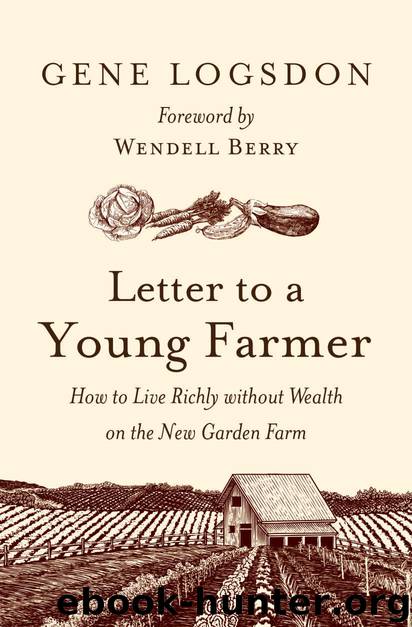Letter to a Young Farmer: How to Live Richly without Wealth on the New Garden Farm by Logsdon Gene

Author:Logsdon, Gene [Logsdon, Gene]
Language: eng
Format: epub
Publisher: Chelsea Green Publishing
Published: 2017-01-26T05:00:00+00:00
CHAPTER 14
Pasture Farming as Part of Garden Farming
Only a relatively few new age farmers have a cultural connection to pasture farming compared to the number who are familiar with gardening. Even for those of us who grew up and have lived on farms most of our lives, modern methods of raising animals almost exclusively on pasture forages is a new idea—or rather a very old idea. Somewhat disbelievingly myself, I spent thirty years experimenting with rotational grazing with eight very small plots of an acre each. I convinced myself that even at this scale, or perhaps especially at this scale, pasture farming works. The know-how involved has advanced considerably since I wrote a book about it, All Flesh Is Grass , and most of it assumes the attitude of industrial farming—that is, see how many animals you can cram on a given pasture to make the most money. Nothing wrong with that, but rotational grazing is even better suited for the part-timer or homesteader who wants to make a little money, maybe, but who is mostly interested in an easy way to produce healthful meat, milk, and eggs with the least amount of time and money. For them, if pasture farming produces tasty, healthful food and pays the taxes and upkeep on the meadows, that’s good enough. The added benefits, that is, the beauty and wildlife diversity that pastures bring to a homestead, plus a place for a pond or a hill for sledding or honey-grazing for bees, or room for solar panels—hey, that’s profit too. When you think about all these free gifts from pasture farming that you don’t have to declare as taxable income, casual rotational grazing begins to look as profitable as a no-nonsense commercial project. But much of what has been written focuses on the commercial aspects of rotational grazing rather than the fine points that can make it a low-cost, low-labor endeavor. So here’s a different take on it.
For the uninitiated, rotational grazing is a kind of livestock and chicken farming that mimics nature much more closely than confined animal facilities. Overhead is low, CO2 pollution low, energy expenditures low, erosion almost nil, and no annual cultivation is necessary. About the only machinery you need is a mower, to cut down uneaten weeds after the grazing animals are moved to another plot in the rotation. You might well be able to do the mowing with a large lawn mower. Rotating the animals from one pasture to another means they always have fresh grass and clover. The casual grazier should understock his pasture—that is, keep fewer animals than the land could actually support so that your animal(s) rarely need any other food except in winter. Where winters are not severe, animals can find some grazing almost all year round.
When to move your animals from one plot to another is almost the whole art and science of this kind of farming. But the main reason for doing it, at least for the non-commercial grazier, is not to
Download
This site does not store any files on its server. We only index and link to content provided by other sites. Please contact the content providers to delete copyright contents if any and email us, we'll remove relevant links or contents immediately.
A Court of Wings and Ruin by Sarah J. Maas(7653)
The Death of the Heart by Elizabeth Bowen(3554)
The Sprouting Book by Ann Wigmore(3546)
Better Homes and Gardens New Cookbook by Better Homes & Gardens(3529)
BraveTart by Stella Parks(3397)
Salt, Fat, Acid, Heat: Mastering the Elements of Good Cooking by Nosrat Samin(3108)
Sauces by James Peterson(3054)
Kitchen confidential by Anthony Bourdain(3016)
The Bread Bible by Rose Levy Beranbaum(3004)
Classic by Mary Berry(2943)
Solo Food by Janneke Vreugdenhil(2931)
Ottolenghi - The Cookbook by Yotam Ottolenghi(2872)
Martha Stewart's Baking Handbook by Martha Stewart(2799)
Day by Elie Wiesel(2721)
Betty Crocker's Good and Easy Cook Book by Betty Crocker(2682)
My Pantry by Alice Waters(2549)
The Plant Paradox by Dr. Steven R. Gundry M.D(2548)
The Kitchen Counter Cooking School by Kathleen Flinn(2489)
Hot Sauce Nation by Denver Nicks(2451)
